Whole Wheat Sourdough Bread
Step-by-step recipe for Whole Wheat Sourdough Bread along with instructions for making a sourdough starter with wild yeast.
Once upon a time, I made all our bread from scratch. Everything from sandwich bread to dinner rolls to cinnamon rolls and hamburger buns. As much as I enjoyed it, over time, I just kind of got out of the habit.
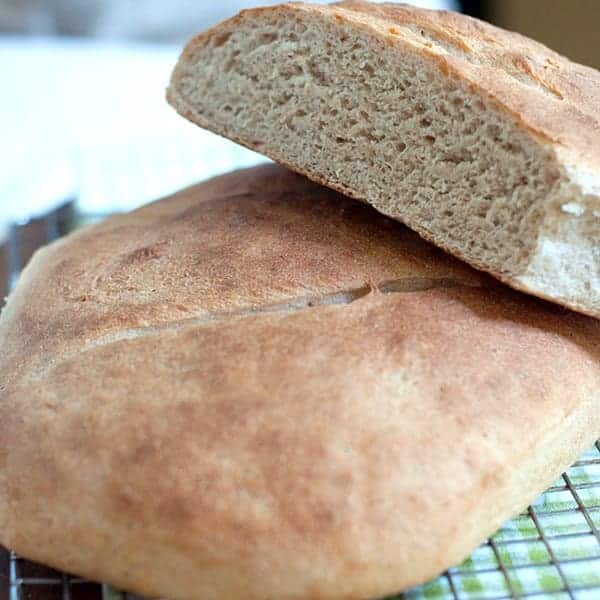
However, working with yeast dough is still one of my most favorite kitchen activities. Yes, it takes a little time, but it’s oh so worth the effort.
There’s just nothing quite like the feel of a yeast dough coming to life as you knead, watching it grow as it rises, and the smell as it bakes…nothing like it! Fresh, warm yeast bread straight from the oven slathered with butter. Name something better.
I recently got an urge to start making bread again. Sourdough bread specifically.
It All Starts With the Starter
Of course, for sourdough you need a starter, right? There are lots of ways to acquire a starter.
You can purchase a commercial starter from sources such as King Arthur Flour and Williams-Sonoma. You can get some starter from a friend who is willing to share.
Or you can make your own. It’s easy. Honestly. It’s also cheap. As in pennies.
If you want to make your own sourdough starter, there are two general methods – with purchased yeast or wild yeast.
What’s wild yeast? Why, it’s the yeast that’s all around us all the time. It’s in the air, on our skin, on fruit, in flour, and probably on your kitchen countertops. It’s just naturally occurring everywhere all the time.
And it’s the way people made bread for thousands of years until yeast became commercially available. It’s not difficult, but it does take a little time and patience.
My Method for Making Sourdough Starter
I want you to understand that this is my method for making sourdough starter. It’s a wild yeast method. Other people have different methods. Mine’s not better or more correct. It’s just my method.
And I’m not certainly not claiming to be an expert. There are lots of folks that know a lot more than I do about sourdough and bread-making in general. If you’re looking for more in-depth information as I often say “Google knows.”
Also, understand that your sourdough starter is going to taste different from everybody else’s. Some are a bit sweeter, some are more sour. That’s because there are different strains of yeast all over the world and the yeast in your environment may be totally different from yeast elsewhere.
The famous San Francisco sourdough bread? It gets its taste from the yeast that naturally lives in that environment. If you got a sourdough starter from someone in San Francisco and took it to New York, it would very soon become a different starter because new strains of yeast would be introduced making it unique to the area where it lives. Make sense?
Making Your Own Wild Yeast Starter
To create your very own sourdough starter, all you need are a clean glass jar, some flour, some water, and a pinch of sugar.
Into your glass jar, add a cup of warm water, a cup of flour, and a pinch of sugar. Stir it together really well. That’s it. That’s the recipe.
However, you’re not quite finished. You now have to “grow” your starter. So here’s what you do. Cover the jar with either cheesecloth or waxed paper and secure it with a rubber band. Sit it in a warm place. It likes to be between 70 and 80 degrees. Just like me :-)
Every 24 hours, stir the starter, take out about half of it and discard that. “Feed” the remaining starter in the jar with 1/2 cup flour and 1/2 cup warm water. After three or four days, maybe sooner, your starter will have doubled in size and have a frothy appearance along with a pleasant yeasty smell. Yay! You have succeeded in making sourdough starter.
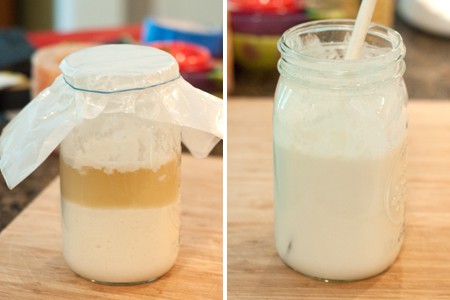
If your starter looks like it has separated and has a brownish-yellowish layer of liquid in it, that’s fine! That stuff is called “hooch” and it’s a natural by-product of the fermentation process. Just stir it back into the starter.
At this point, store your starter loosely covered in the refrigerator until you’re ready to use it in a recipe.
Care and Feeding of Your Starter
Whenever you want to make a sourdough recipe, take the starter out the night before and allow it to come to room temperature. Use what you need to make your recipe for bread or rolls or pancakes or cinnamon buns…whatever… and then feed the starter and place it back into the refrigerator.
If you don’t use the starter for a week, you’ll still need to feed it. Discard half, feed it and put it back in the fridge.
People keep starters for years (even decades!) using this method. If you want to try a really old starter, you can get the 1847 Oregon Trail sourdough starter for just the cost of an envelope and postage. I have a jar of it in my fridge right now. It’s a nice, mellow starter. Not too sour, not too sweet.
Whatever method you use to get your starter going, I hope you’ll use some of it to make a couple of loaves of this Whole Wheat Sourdough Bread. It’s our favorite.
How to Make Whole Wheat Sourdough Bread
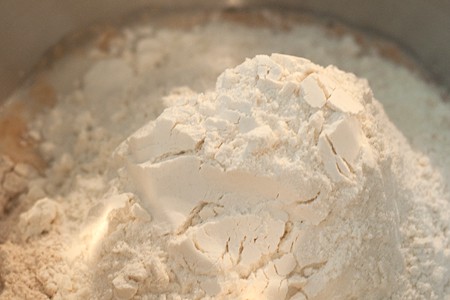
Combine all ingredients in the bowl of an electric stand mixer fitted with a dough hook.

Knead on slow speed (#2) until a smooth dough forms (about 4-6 minutes). (Alternately, combine all ingredients in a large bowl. Stir with a wooden spoon until the dough begins to come together. Turn out onto a floured surface and knead until a smooth dough forms (about 10 minutes).)
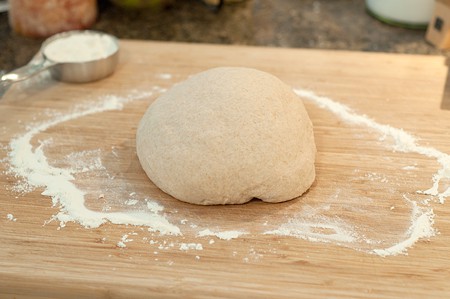
Remove the dough from the mixer and knead 4 or 5 times on a floured surface to create a nicely rounded ball.
Place the dough in a large bowl and let it rise for about 90 minutes, lightly covered, in a warm place until doubled in size.
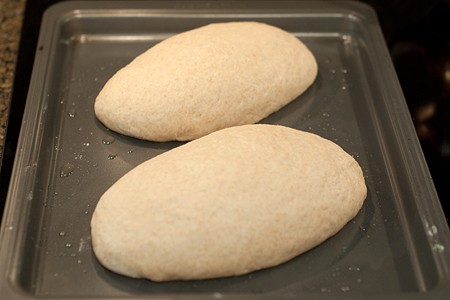
Divide the dough in half. Shape into two oval loaves and place on a parchment-lined or lightly oiled baking sheet. Cover and let rise again for about 1 hour. Near the end of the rising time, preheat the oven to 425 degrees.
Make two deep, diagonal slashes in each loaf.
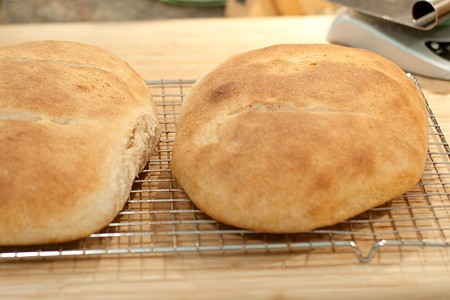
Bake for 25 to 35 minutes or until deeply golden brown. Place on a baking rack to cool.
🧾 More Recipes You’ll Like
- Easy Homemade Bread
- Cheddar Dill Quick Bread
- Brown Irish Soda Bread
- Homemade Pull-Apart Rolls
- Steakhouse Honey Wheat Bread
- Cheesy Onion and Herb Bread
- Carrot-Pecan Quick Bread

Questions? I’m happy to help!
If you have more questions about the recipe, or if you’ve made it and would like to leave a comment, scroll down to leave your thoughts, questions, and/or rating!
Thanks so much for stopping by!
Want to save this recipe?
Enter your email below and get it sent straight to your inbox.
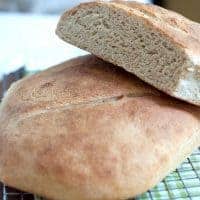
Whole Wheat Sourdough Bread
Ingredients
- 1 cup room temperature sourdough starter
- 1 ½ cups lukewarm water
- 1 package dry active yeast
- 1 tablespoon granulated sugar or honey
- 2 ½ teaspoons salt
- 2 cups unbleached bread flour
- 2 cups whole wheat flour
Instructions
- Combine all ingredients in the bowl of an electric stand mixer fitted with a dough hook.
- Knead on slow speed (#2) until a smooth dough forms (about 4-6 minutes). Alternately, combine all ingredients in a large bowl. Stir with a wooden spoon until the dough begins to come together. Turn out onto a floured surface and knead until a smooth dough forms (about 10 minutes).
- Place the dough in a large bowl and let it rise for about 90 minutes, lightly covered, in a warm place until doubled in size.
- Divide the dough in half. Shape into two oval loaves and place on a parchment-lined or lightly oiled baking sheet.
- Cover and let rise again for about 1 hour.
- Near the end of the rising time, preheat the oven to 425 degrees.
- Make two deep, diagonal slashes in each loaf.
- Bake for 25 to 35 minutes or until deeply golden brown.
- Place on a rack to cool.
Notes
Nutrition Information
Nutrition information is calculated by software based on the ingredients in each recipe. It is an estimate only and is provided for informational purposes. You should consult your healthcare provider or a registered dietitian if precise nutrition calculations are needed for health reasons.

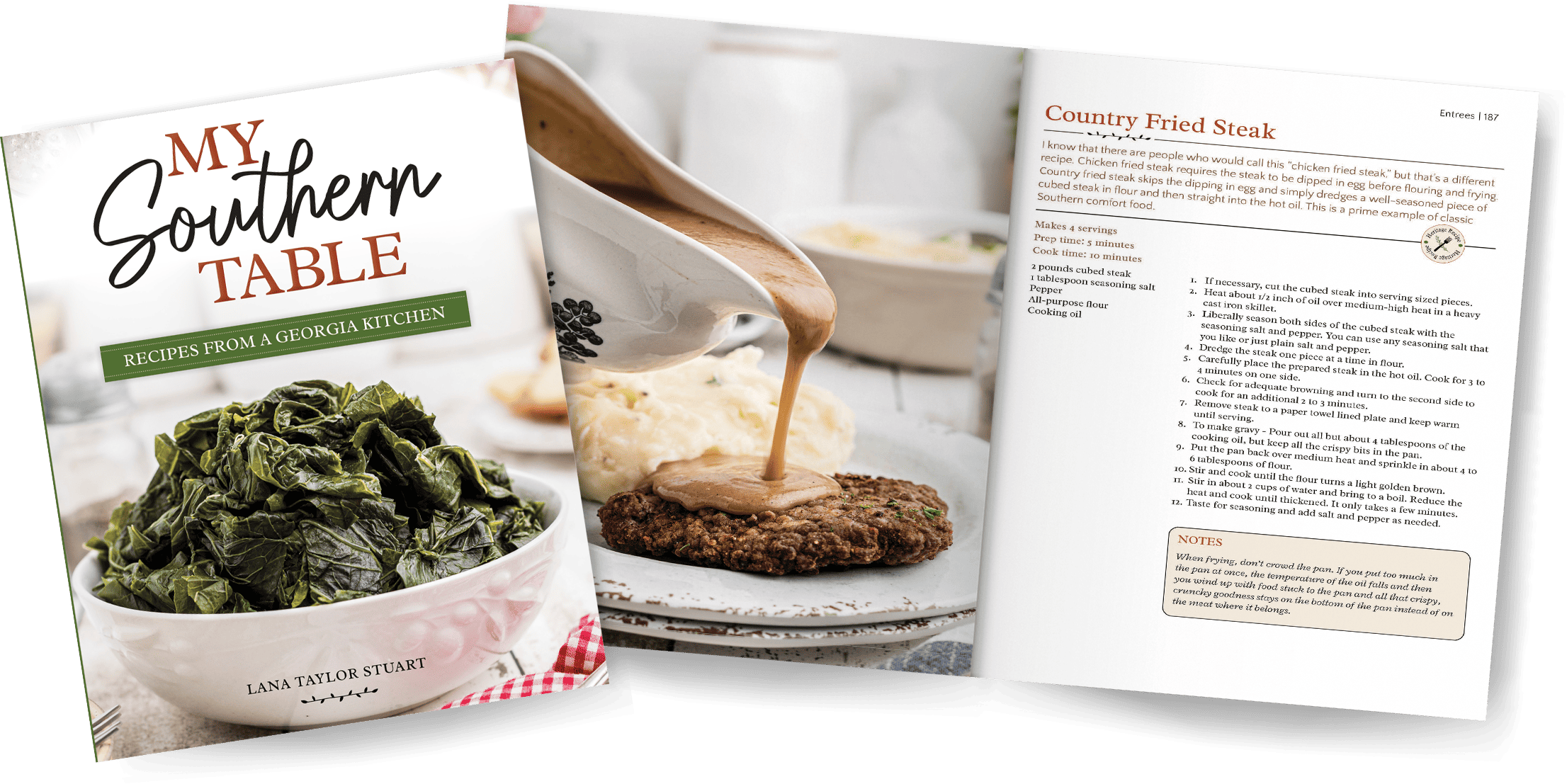
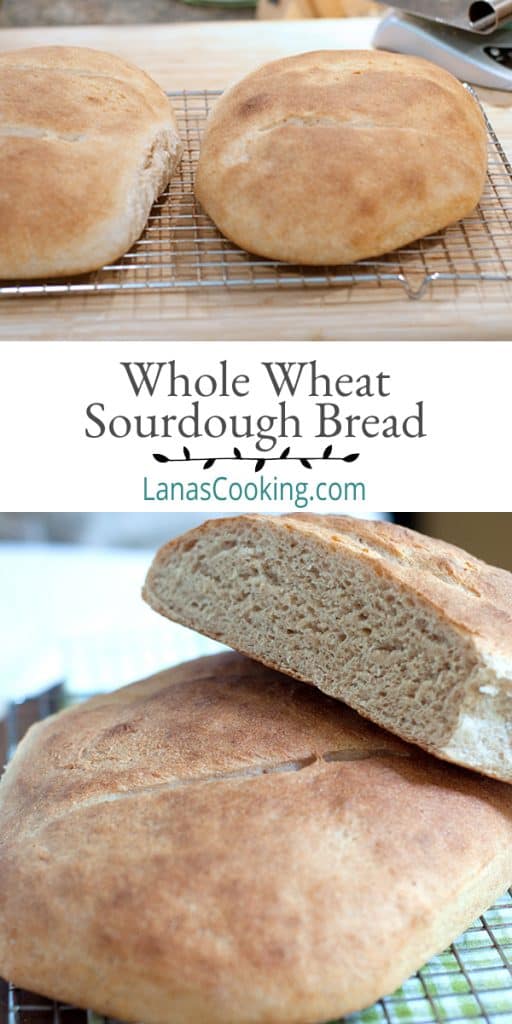
Lana, I like how you point out there are many ways to make a sourdough wild yeast starter. I didn’t use any sugar in mine, but that’s okay too. Like I always say, it’s pretty hard to mess up really! :D
I have on my list to do, to make starter. It just sounds like fun to make:-) Your bread looks gorgeous! Hugs, Terra
It is fun, Terra! I hope you’ll try it soon.
I need to come back and follow your instructions for making bread. It has always been on my bucket list and I have yet to try. Yours look fantastic!
A couple of times in my life I had sour dough starter just like my Mom. I had good luck with it, even though I was a newbie. You wait long enough between doing something you are a newbie again. Actually I had forgotten about sour dough starter. Thanx for the reminder.
Thanks for all the good information about yeast. Baking yeast breads is my favorite thing to do in the kitchen and I especially love using sourdough starter. Thanks for sharing your method, Lana!
I’m so glad that I decided to get back into bread backing, Renee. It’s one of my favorite things, too!
Sourdough is my favorite! I have never had it whole wheat but I’m totally curious now!
I really like it. You get both the nutty flavor from the whole wheat and the tangy sourdough. It’s delicious.
Ok, technical question. Can I substitute regular all purpose flour for the bread flour? Inquiring minds want to know.
Miss P
Yep, sure can. It’ll have a little different texture but will still work. You can also make this recipe with all bread flour or all all-purpose flour and no whole wheat. Works either way. I just like to have the whole grain stuff in mine.
I’ve never made sourdough bread at home. You’ve inspired me to try!
I’m so glad I could encourage you to try something new! If you have any questions, just ask.
I need to get back into making homemade bread. It really is so much better! This looks so good!
No comparison, is it? I’m so glad I started back baking bread.
Fantastic! My husband is actually the bread maker in the family and I am passing this one on to him! Thanks!
Great, Ginny! I hope he enjoys making it.
I’ve never made sourdough bread before, or any kind of bread for that matter. I’m excited to try this out!
I just love bread making, Kim. It’s one of the oldest and most fundamental foods in the world. Every culture has some sort of bread.
I love baking breads from scratch. I’ve never attempted a sourdough, although I do love it. thanks for the inspiration.
My pleasure, Christine. Just give it a try and I think you’ll really like using a starter in your breads.
I’ve never attempted a sour dough but your method doesn’t looks so scary!
It’s not scary at all, Brenda! Just give it a try and you’ll see.
I still haven’t done a sourdough bread, and never thought to do a whole wheat sourdough, what a great idea!
I hope you’ll try it, Angie. It just might become your favorite bread. It’s definitely mine.
One of these days I will take the plunge into sourdough – and when I do I just may eat the whole loaf! Yours is perfect!
That’s exactly the problem, Colleen! I cannot resist that warm, yeasty bread straight from the oven. So good!
I’ve been wanting to try sourdough for awhile, but the starter has always intimidated me. Thanks for the clear explanation and directions.
Don’t let the starter intimidate you, Courtney! It’s just a little flour and water with a pinch of sugar. And if it doesn’t work the first time, try, try again!
You are my inspiration!! I’ve always, always wanted to make my own sourdough.
It’s so easy, Claire. I do hope you’ll give it a try.
I have never made sourdough bread before but I can’t wait to try your recipe! :)
I hope it works out well for you, Jenn.
this looks amazing! I also need more experience making bread from scratch! Such a great and informative post to learn by! I am taking notes!
Thanks Amanda. I hope you’ll give it a try. Making your own bread from scratch is very rewarding.
Your sourdough looks great Lana as well as looking pretty darn tasty! I love making sourdough and have been doing so for quite a few years now. My starter or favorite starter is a mixture of buttermilk and flour as I like the extra tang the buttermilk adds. I don’t use yeast in my sourdough so the rising time can be unpredictable depending on the time of the year, weather, and how active my starter might be leaving the rising time sometimes within a couple of hours to sometimes a full day, but even so, it’s always worth the wait!
Thanks for the recipe Lana, will give it a go for sure!
PS.. Not positive if this has worked (or if it is permitted) as my computer skills in transferring photos are pathetically limited but here’s a peek at a couple of sourdough boules I’ve made.
Cheers!
Wow, that looks amazing! I tried making sourdough starter once (in the winter, when it was cold). It did not go very well. :D But your boules look delicious, wish I had a warm slice right now! :)
I bet if you try it again now, you’d have better luck! It likes the warm weather :-)
I am definitely going to try this. I have never had any luck making bread, but maybe this will work. Thank you for this post.
Bread, or really any yeast dough, is just about my favorite thing to bake. I think it’s because it’s a sturdy dough. Cakes and pies are hard for me because you have to be delicate with them.